Since Bitcoin fell below $90,000 on February 25, the crypto market has experienced a broad-based crash. Today, Bitcoin has fallen below $79,000, reaching a new low since November 12, 2024; Ethereum has also fallen below $2,100, returning to the November 2023 level. As the market sentiment remains in a "state of extreme panic", despite the massive declines in Bitcoin and Ethereum, there are still no signs of the downtrend stopping, leaving the market in a suffocating situation.
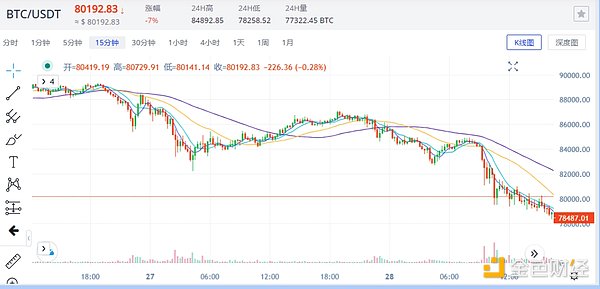
Heightened Concerns over U.S. Economic Recession
The drastic market adjustment is directly related to the deterioration of the macroeconomic environment. As the U.S. economy shows signs of weakening, recession concerns have resurfaced.
Data shows that U.S. consumer confidence plummeted sharply in February, the largest decline since August 2021. Consumers are cutting back on various expenditures, and data released on Thursday showed that the U.S. pending home sales index fell 4.6% month-on-month in January, far exceeding expectations and hitting a record low. Additionally, retail giant Walmart's earnings forecast expects a significant slowdown in performance growth in fiscal year 2026, which, as an important barometer of U.S. consumer spending, has raised investors' concerns about the consumer outlook.
At the same time, the pace of U.S. economic expansion slowed to near stagnation in February. The U.S. composite PMI hit a new low in 17 months this month, with "business activity near stagnation". Even more pessimistic is that the crucial service sector activity in the U.S. economy hit a new low since January 2023, entering the contraction zone for the first time in more than two years.
As a reflection of recession concerns, the 10-year U.S. Treasury yield has fallen below the 3-month U.S. Treasury yield, resulting in an inverted yield curve, which has been a typical recession warning signal in the past few decades.
A series of weak macroeconomic data, coupled with Trump's confirmation of the implementation of tariffs on Canada and Mexico as scheduled, and his threat to impose taxes on the EU and more countries, have formed the core logic behind the recent significant rise in U.S. economic "stagflation" expectations. Based on this, investors' risk appetite has rapidly declined, with the U.S. stock market experiencing sell-offs for several consecutive days, and popular tech stocks plummeting from their highs, with cumulative declines ranging from 10% to 35%. For example, Nvidia has fallen 14.18% this week, while Tesla, often seen as a "Trump trade" barometer, has fallen 20.18% this week, down nearly 40% from its peak since Trump's election.
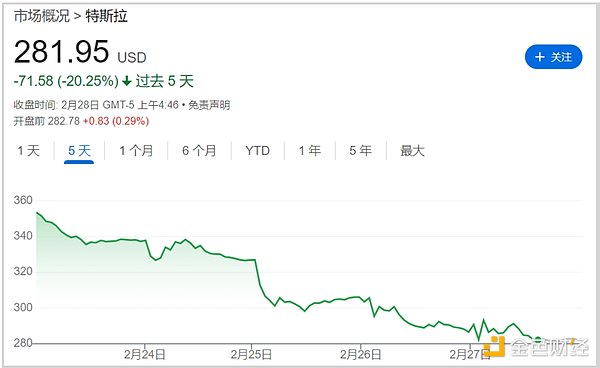
Due to the strong correlation between Bitcoin and tech stocks, Bitcoin has experienced a significant decline driven by the U.S. stock market. Additionally, the review process of state-level Bitcoin-related bills in the U.S. has also begun to stall, and the passage of Bitcoin bills does not seem as smooth as the market had imagined, which has to some extent weakened the market's confidence in the "Crypto-friendly" stance of the Trump administration and the commitment to national Bitcoin reserve.
Continuous Capital Withdrawal
Since February, Bitcoin spot ETFs have experienced a severe "bleeding effect", and as an important inflow channel for institutional capital, their fund flow data is also a key indicator affecting market confidence. However, throughout February, Bitcoin spot ETFs have been experiencing net outflows.
According to Coinglass data, from February 18 to 27 Eastern Time, U.S. Bitcoin spot ETFs experienced 8 consecutive days of net outflows, with a net outflow of $1.14 billion on February 25, the largest single-day net outflow since their launch, reflecting the pessimistic expectations of institutional investors on the short-term price trend.
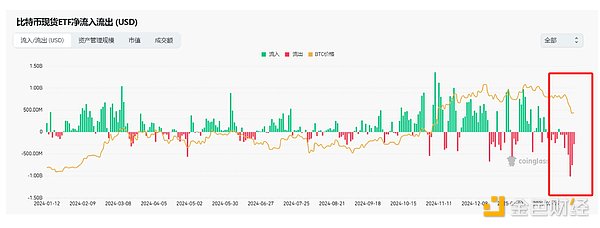
On-chain data also shows that Bitcoin market liquidity is rapidly shrinking, especially the withdrawal of large capital. According to data from the well-known KOL Murphy, the whale group (transactions over $10 million) that had dominated the market rally, saw its liquidity share increase from 30% in April 2023 to 62% by November 2024, but has since plummeted to 38% as of this February. High-net-worth groups (transactions between $1-10 million) have also been reducing their holdings since January, with their liquidity share dropping from 36% to 30%. Meanwhile, the retail share has been increasing, indicating that retail investors were FOMO-ing in as Bitcoin broke $100,000, while large capital was gradually withdrawing.
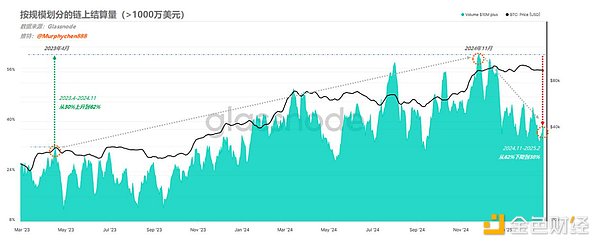
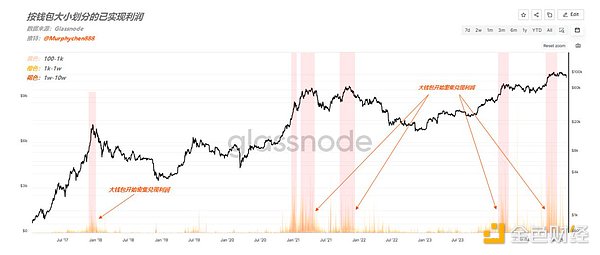
Further data shows that the withdrawal of large capital is highly correlated with profit-taking, and whenever wallets holding 1,000-100,000 BTC start to cash out on a large scale, the upward trend of Bitcoin tends to come to an end. This phenomenon has been clearly manifested in 2017, 2021, and 2025, highly coinciding with the timing of whale capital withdrawal. The current market is experiencing a typical pattern of capital flow: large capital is cashing out, while retail investors are belatedly picking up the pieces.
Is It Time to Buy the Dips?
As the market continues to decline, with Bitcoin falling below $79,000 and plummeting over 18% in the past week, the market is starting to consider whether it's time to buy the dips.
Currently, the crypto market is trapped in a vortex of multiple adverse factors: the shadow of economic stagflation looms over all risk assets, the tech stock sell-off is exerting downward pressure on Bitcoin through the risk appetite transmission mechanism, and the severe imbalance in the crypto market's internal capital structure - with institutional capital continuously outflowing, whale accounts accelerating profit-taking, and retail buying power dwindling - have all contributed to the depth and ferocity of this decline. Historical lessons reveal that when market liquidity shifts from institutions to retail, it often signals the critical turning point between bull and bear markets.
Although short-term oversold conditions may trigger a technical rebound, given the uncertainty surrounding Trump's policies, the Federal Reserve's monetary policy outlook, and the lack of news on the much-anticipated national Bitcoin reserve strategy for the next six months, investors should be highly wary of the risks of "buying the dip traps".
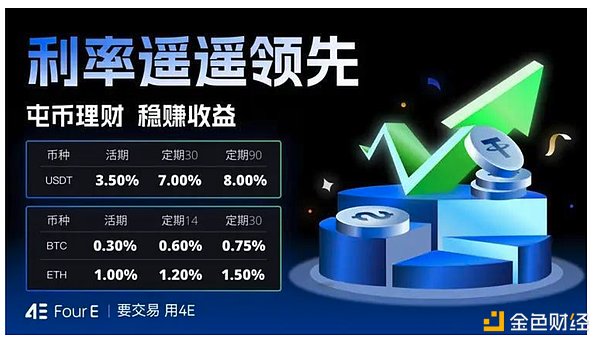
In the midst of a market atmosphere permeated by panic, maintaining financial flexibility and ample liquidity may be of greater long-term strategic value than blindly chasing rebounds. 4E, as the global partner of the Argentine national team and the only recommended trading platform, offers USDT wealth management products with annualized yields of up to 8%, allowing you to flexibly combine on-demand and fixed-term deposits, so that your funds are not idle but can wait for market changes and invest flexibly.








